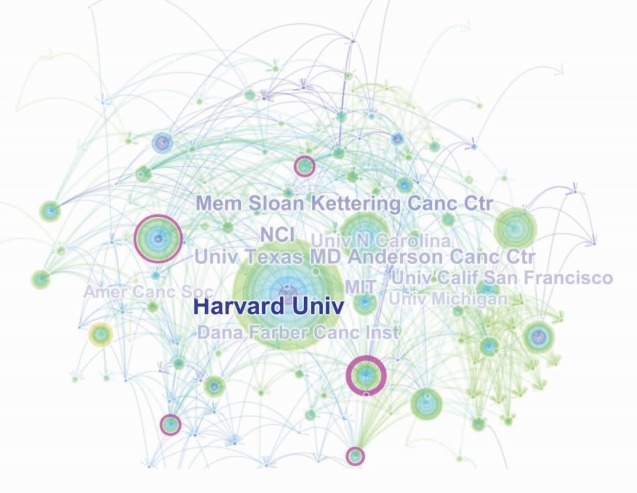Abstract
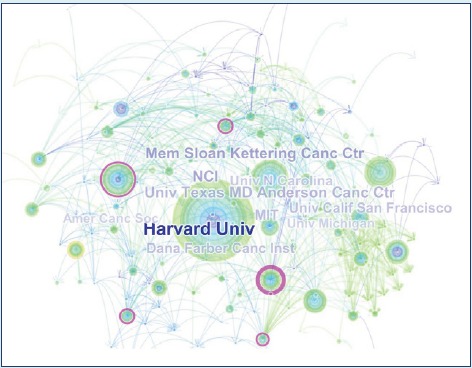
Introduction: Breast cancer is one of the highest reasons of deaths for people in the world. The objective of current study is to analyze and visualize the trend of global scientific activities in the field of breast cancer during a period of 10 years through 2006-2015.
Methods: The current study was performed by utilizing the scientometrics analysis and mapping the co-authorship and co-organization networks. The Web of Science Core Collection (WoS-CC)database was used to extract all papers indexed as a topic of breast cancer through 2006 to 2015. Research productivity was measured through analysis several parameters, including: the number and time course of publications, the journal and language of publications, the frequency and type of publications, as well as top 20 active sub-categories together with country contribution. The extracted data were transferred into the Excel charts and plotted as diagrams. The Science of Science (Sci2) and CiteSpace softwares were used as tools for mapping the co-authorship and co-organization networks of the published papers.
Results: Analysis of data indicated that the number of publications in the field of breast cancer has linearly increased and correlated with the time-course of the study. The number of publication indexed in WoS-CC in 2015 was two times greater than that of 2006, which reached from 15 229 documents in 2006 to 30 667 documents in 2015. English Language accounted for 98% of total publications as the most dominant language. The vast majority of publications' type was in the form of original journal articles (64.7%). Based on Bradford scatterings law, the journal of "Cancer Research" was the most productive journal among the core journals, while the USA, China, and England were the most prolific countries in the field. The co-organization network indicated the dominant role of Harvard University in the field.
Conclusion: The integrity of network indicated that scientists in the field of breast cancer working collaboratively to tackle the number one threat in women health.
Keywords: Breast cancer, Co-authorship, Co-organization, Publication network, Scientometrics analysis
Introduction
Breast cancer is identified as the most pervasive diagnosed neoplasms in women worldwide, which is the second cause of deaths among women after cardiovascular diseases.1 Breast cancer is recognized as the most frequently identified cancer among women. It is positioned in the second rank of leading cause of deaths in the USA. Breast cancer differs from other types of cancers in a way that it happens in a visible organ, which can be detected/diagnosed and treated at the early stages.2 Breast cancer remains as the common cause for women’s deaths with 1.35 million new cases per annum. Research in the field of breast cancer is rigorously performed worldwide.1-3 The According to the American Cancer Society, about 231 840 new invasive breast cancer cases were identified in women in the United States during 2015 and almost 2350 cases in men.4
Global statistics confirmation indicates that the annual prevalence of the breast cancer continues to grow rigorously and more rapidly worldwide, even in the countries in which the rate of breast cancer is low.5 On the other hand, the global statistics of breast cancer show the incidence of the disease is growing at a faster rate among people of the developing countries.6,7 It is estimated that the occurrence of the breast cancer in the developing countries is due to the adoption of westernized lifestyles like consumption of the fast foods, exogenous hormonal intake, smoking, lack of physical activity, alterations in childbearing and breast feedings.8
It is estimated that 61% of the breast cancer cases are identified at the localized stages, in which the 5-year survival rate is very high, even up to 99%.9 Spreading the cancer into the tissues close to the breast, may cause the survival rate falls down to 85%, and if the cancer cells invade the lymph nodes of collarbone or to the distant lymph nodes and/or organs, the survival rates may drop to 25%.10 In a study conducted by Zehtab et al, it was shown that the number of patients suffering from the breast cancer has been growing during the past 15 years. Their study also emphasized that a great number of cases with the breast cancer are found through the screening method.11
Inherited genetic mutations and the family history are the main risk factor of the breast cancer in women. Factors which may increase the breast cancer risks, consist of: (a) long menstrual history, (b) weight gain after menopause, (c) oral contraceptives, (d) hormone-therapy of post-menopausal, (e) never bearing child, (f) bearing the first child after age 30, and (g) characteristics background, radiation exposures. Further, the long-term heavy smoking may increase the risk of breast cancer, especially for women who start smoking before the first pregnancy.12 Painless lump or mass in breasts are the most common symptoms of the breast cancer.4
Research and scientific activities in the field of breast cancer is an important index for understanding the cultural and genetics differences of people in dissimilar geographical regions. Therefore, global analysis and tracking of the scientific activities in the filed of breast cancer play an pivotal role in the policies and strategies for prevention and treatment of breast cancer. On the other hand, the research activities would reflect the clinical practice, screening programs, awareness, and epidemiological data. Analysis of the scientific activities of individuals and institutions is a reliable method for assessing the research trend worldwide.
One of the major applications of the scientometrics is analysis of scientific activities, which provides ability to map the global research activities from various prospectives. The scientometrics dominion refers to the measurement of science using reliable quantitative methods for the evaluation of scientific development. Scientometrics may provide various possibility for mapping of scientific literature network profile in the scientific communities. Of these, the mapping of the co-authorship is one of the most popular features of such endeavor tracking the distribution and collaboration in the global scientific network. The main objective of current study was to address the trend of global scientific activities in the field of breast cancer during a period of 10 years from 2006 to 2015, and to map the networks of co-authorship and co-organizations. This study could highlight the centrality and importance of institutions and researchers that play important roles in tackling such disease.
Materials and methods
A scientometrics study was recruited to address the co-authorship network and the trend of publication in the field of breast cancer during years 2006-2015.
The WoS-CC was used for extracting all papers indexed as a major topic of “breast cancer” during years 2006-2015. Limiting the extraction of papers in the topic retrieved the most relevant papers in the field.
The search strategy was designed based on the inclusion of the “breast cancer” term in the search box and limiting the search into the topic by selecting the tag of topic from the list of field-tags. The time span was limited to ten years (i.e., 2006-2015). This approach resulted in collection of 229 763 documents, which were divided into several sub-categories. The WoS-CC provides the administrators, researchers, faculty, and students with swift and powerful access to the international citation databases. This authoritative and multidisciplinary database covers more than 12 000 accredited journals worldwide, including the open access journals, and more than 160 000 conference papers. The present and backdated literature of science in the sciences, mathematics, arts, social sciences, and humanities which are reachable since 1900.
Mapping the co-authorship and co-organization networks was planned by science of science (Sci2) and CiteSpace tools. Mapping the co-authorship and co-organization networks is an essential class of scientific social-networks, which is used for showing the key structure of scientific collaboration and the position of organization and/or individual authors.
For clear illustration of co-authorship network, we included the papers that cited at least two times in the WoS-CC. The exclusion of the papers cited less than two times in the field might provide more clear maps.
Data about the population of countries were extracted from the website of World Databank (http://databank.worldbank.org/).
Results
The extraction of data provided 229 763 documents in different format of publications during 2006-2015. Analysis of data indicated that the number of publications in the field of breast cancer indexed in the WoS-CC has increased linearly throughout period of 2006-2015 (Fig. 1). The number of publications in 2015 displayed 2-fold increase as compared to that of 2006 (i.e., from 15 229 to 30 667 papers, respectively). The average number of publications was 22 976 papers per annum in the period of the study.
Fig. 1.
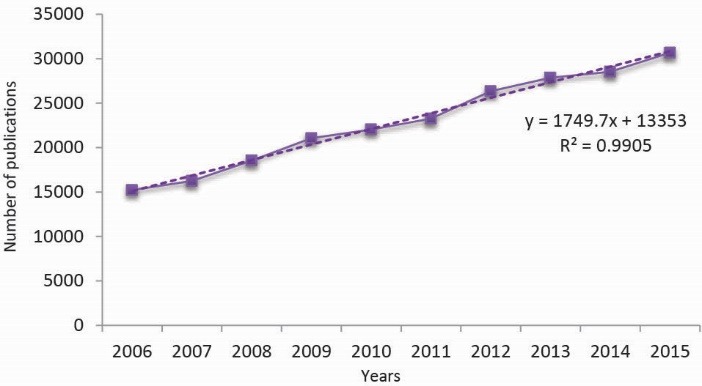
Number of publications in the field of breast cancer indexed by the Web of Science Core Collection during 2006-2015.
Table 1 shows the contribution of countries (%) for researchers sharing their papers in the area of the “breast cancer” during the period of the study. Based on our findings (Table 1), the USA was the most productive country producing 39% of whole publications in the field of breast cancer. The following countries were China (10.2%), England (6.7%), Germany (6.4%) and Italy (5.5%). The column representing "optimized rank" in Table 1 shows the rank of countries based on the number of publications divided to the number of population.
Table 1. Origin country of publications in the field of breast cancer indexed by the Web of Science Core Collection during 2006-2015 .
| Rank | Countries | No. of papers | Percent | Population | No. of papers/million population | Optimized Rank |
| 1 | USA | 89815 | 39.090% | 321 191 000 | 279.7 | 8 |
| 2 | China | 23546 | 10.248% | 1 370 840 000 | 17.1 | 18 |
| 3 | England | 15478 | 6.737% | 63 489 234 | 245.6 | 9 |
| 4 | Germany | 14926 | 6.496% | 80 930 000 | 186.5 | 11 |
| 5 | Italy | 12685 | 5.521% | 60 772 000 | 211.4 | 10 |
| 6 | Canada | 12131 | 5.280% | 35 883 000 | 346.6 | 5 |
| 7 | France | 10787 | 4.695% | 66 477 000 | 163.4 | 13 |
| 8 | Japan | 10694 | 4.654% | 126 820 000 | 84.8 | 16 |
| 9 | South Korea | 7579 | 3.299% | 50 293 439 | 151.5 | 15 |
| 10 | Australia | 7261 | 3.160% | 23 802 000 | 315.6 | 7 |
| 11 | Netherlands | 7155 | 3.114% | 16 917 000 | 447.1 | 4 |
| 12 | Spain | 7039 | 3.064% | 46 460 000 | 153 | 14 |
| 13 | Sweden | 4551 | 1.981% | 9 766 000 | 505.6 | 2 |
| 14 | India | 4521 | 1.968% | 1 311 051 000 | 3.44 | 20 |
| 15 | Taiwan | 4067 | 1.770% | 23 381 038 | 176.8 | 12 |
| 16 | Switzerland | 3838 | 1.670% | 8 265 000 | 479.7 | 3 |
| 17 | Belgium | 3724 | 1.621% | 11 301 000 | 338.5 | 6 |
| 18 | Turkey | 3279 | 1.427% | 76 819 000 | 43.1 | 17 |
| 19 | Brazil | 3212 | 1.398% | 207 848 000 | 15.5 | 19 |
| 20 | Denmark | 3137 | 1.365% | 5 660 000 | 627.4 | 1 |
Having calculated the productivity of a country based on the population, we found that the top 5 productive countries (after reassessing the respective population size) were: Denmark, Sweden, Switzerland, Netherlands, and Canada.
As shown in Table 2, the prominent language of publication was the English language. Almost 98% of total publications was in English, and 2% in other languages. This should not come as a surprise while the database of WoS has been focused on indexing papers in English since many years ago.14
Table 2. The language of papers in breast cancer indexed in the WoS Core Collection in years 2006-2015 .
| Language | Records | Percent |
| English | 224 414 | 97.75% |
| French | 1704 | 0.74% |
| German | 1496 | 0.65% |
| Spanish | 582 | 0.25% |
| Russian | 498 | 0.22% |
| Polish | 283 | 0.12% |
| Korean | 209 | 0.09% |
| Portuguese | 174 | 0.08% |
| Chinese | 134 | 0.06% |
| Turkish | 83 | 0.04% |
As illustrated in Fig. 2, the vast majority of publications (64.7%) was in the form of original journal articles followed by abstract (16.5%) and review (10%). Some papers (5.8%) were published in the form of meeting, editorial, letter and correlation.
Fig. 2.
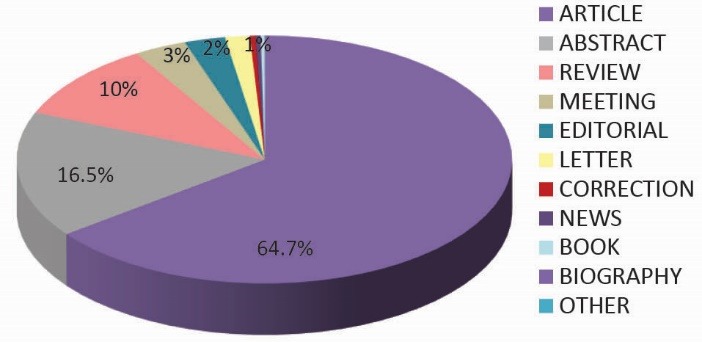
Frequency of publication types in the field of breast cancer during 2006-2015.
Fig. 3 shows the list of productive journals in the in the field of breast cancer. These data are restricted to the journals with a contribution over 2000 papers in the field. From all the journals published papers in the field of breast cancer, the journal of “Cancer Research” was the most productive journal, publishing 5.14% (11,818 papers) of total papers. It was followed by “Journal of Clinical Oncology” 3.60% (8260 paper), “Breast Cancer Research and Treatment” 2.39% (5484 papers), “PLOS One” 2.16% (4953 papers), “Annals of Oncology” 1.43% (3297 papers), “European Journal of Cancer” 1.30% (2994 Papers), “Breast” 1.15% (2648 papers), “Annals of Surgical Oncology” 1% (2293 papers), “EJC Supplements” 0.91% (2090 papers), “Clinical Cancer Research” 0.90% (2071 papers) and “BMC Cancer” 0.89% (2047 papers).
Fig. 3.
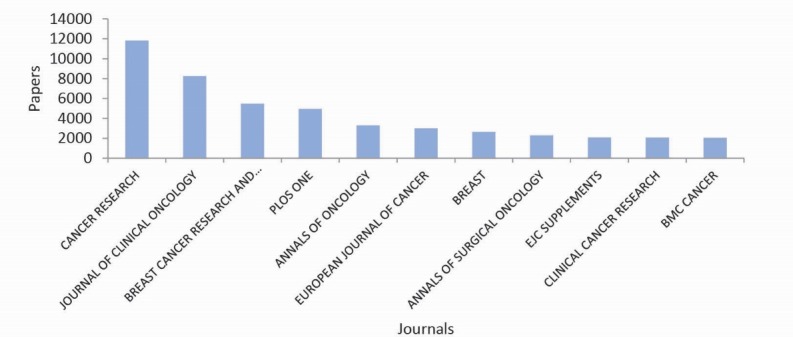
Frequency of journals that published papers in the field of breast cancer 2006-2015.
Table 3 shows the sub-categories of papers in the field of breast cancer. More than 51% of papers were classified in oncology. The following sub-categories are: biochemistry molecular biology, cell biology, pharmacology pharmacy, radiology nuclear medicine medical imaging, obstetrics gynecology, pathology and surgery respectively. Data presented in Table 3 were restricted to 20 top sub-categories of papers in the field of breast cancer.
Table 3. The twenty top sub-categories of breast cancer in the WoS Core Collection in years 2006-2015 .
| WoS Core Collection categories | Records |
| Oncology | 117 541 |
| Biochemistry molecular biology | 22 666 |
| Cell biology | 16 848 |
| Pharmacology pharmacy | 16 667 |
| Radiology nuclear medicine medical imaging | 14 415 |
| Obstetrics gynecology | 11 377 |
| Pathology | 10 364 |
| Surgery | 10 207 |
| Science technology other topics | 10 140 |
| Research experimental medicine | 10 043 |
| Public environmental occupational health | 9313 |
| Chemistry | 8299 |
| Genetics heredity | 8138 |
| General internal medicine | 7779 |
| Endocrinology metabolism | 6237 |
| Engineering | 5205 |
| Health care sciences services | 4919 |
| Biotechnology applied microbiology | 4886 |
| Psychology | 4656 |
| Biophysics | 3344 |
The list of top 10 prolific authors is shown in Fig. 4. Wang Y from Sichuan Univ, West China Hosp, (China) was found to have contribution in 1003 papers in the field as the most productive researcher. The following productive authors were: Zhang Y contributing 996 papers from the Yale Univ, Sch Med, Dept Therapeut Radiol, New Haven, CT 06510 USA, and Li Juan contributing 858 papers from Clin Res Inst Montreal, Mol Oncol Lab, Montreal, PQ H2W 1R7, Canada.
Fig. 4.
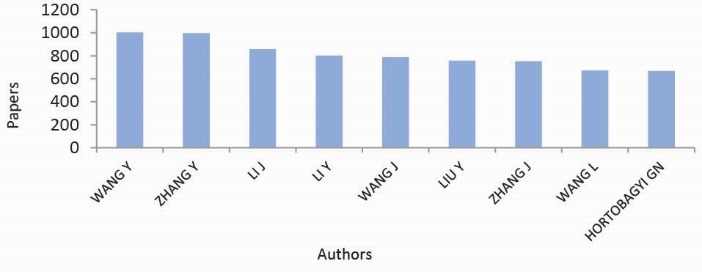
Ten top productive researchers sharing papers in the field of breast cancer in the WoS Core Collection in years 2006-2015.
Fig. 5 shows the co-authorship network of breast cancer papers indexed in the WoS-CC during the period of study. The network consisted of 10 998 nodes, 280,617 links, and 370 clusters. One could name it as a connected network, in which its density was 0.0046. It should be noted that the density measures the degree of the nodes’ cohesion. If its value is close to one, then it represents more cohesive network. If it is close to zero, it indicates the less coherence of the network. The giant component in the center of co-authorship network with 7286 nodes was the biggest cluster.
Fig. 5.
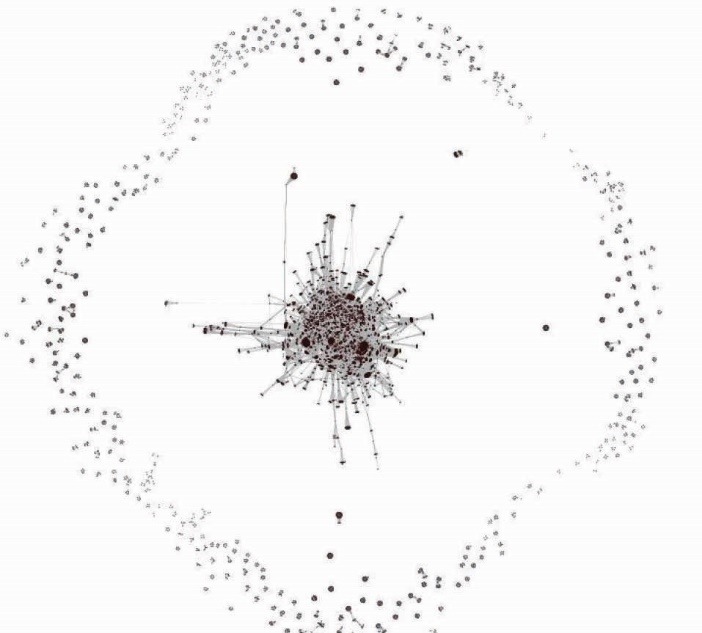
The co-authorship network of papers in the field of breast cancer in WoS Core Collection in years 2006-2015.
Small world analysis can only be done in a connected graph. Thus, in this graph we used the major component of the co-authorship network for the measurement. The component in the network is a fraction of a network, in which all authors are related either directly or indirectly through network (no less than one tie).15 Analysis of component generates a representation from the whole structure of network, indicating how it is fragmented and hence providing valuable information on its position and opportunities that is valuable for the strategic management. The map is restricted to the giant component of the co-authorship network, in which all small sub-networks have been removed and those authors who had at least 2 times co-authorship remained in the network for better consideration and analysis (Fig. 6).
Fig. 6.
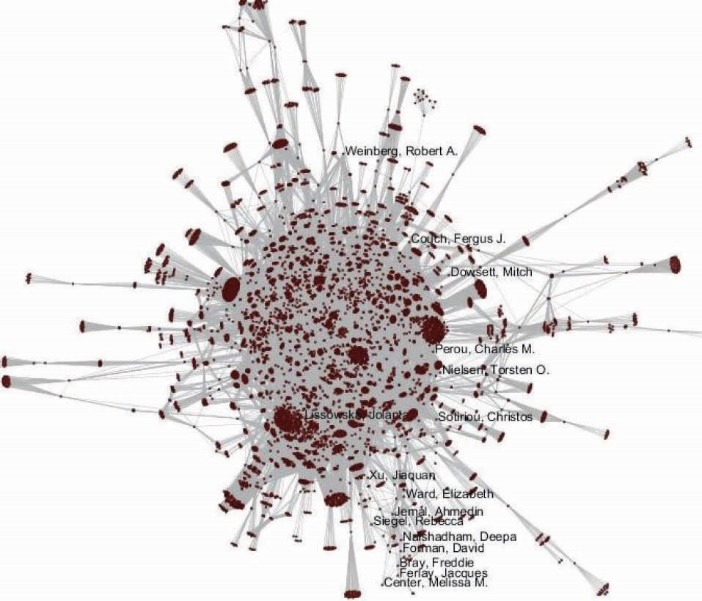
The giant component of co-authorship network of papers indexed in breast cancer in WOS Core Collection during 2006-2015.
Each node representing one author, and the links between two nodes specifies co-authorship between the two authors. The network illustrates strategic positions of some authors shaping the co-authorship network, without which it would have been divided into some sub-networks.16 The strategic authors in the co-authorship network are called "cut-points" and the links between them is called bridges.17
Fig. 7 shows the network of organizations that published papers in the field of breast cancer. Each node is the presenter of an organization, the link between 2 organizations means that they shared the authorships of the published papers. The size of nodes in the map express the centrality degree of the organizations. The thickness of links between organizations indicates the amount of collaboration between them. The density of the network was 0.0373, which means the network was a connected network.
Fig. 7.
Global network of organizations that published papers in the field of Breast Cancer.
As shown in Fig. 7, Harvard University is the top productive organization publishing papers in the field of breast cancer. The following organizations include: Memorial Sloan Kettering Cancer Center, National Cancer Institute, The University of Texas MD Anderson Cancer Center, The University of California, Massachusett Institute of Technology, Dana–Farber Cancer Institute, The University of North Carolina, The American Cancer Society, and The University of Michigan.
For an improved visualization, only the leading component was shown in the map and the names of top organizations with premier centrality in the map were labeled (Fig. 7).
Discussion
The major aim of the current study was (a) to visualize and analyze the co-authorship and co-organization of scientific output in the field of breast cancer indexed in the WoS-CC during 2006-2015, and (b) to show the status and importance of authors as well as organizations that played important roles in constructing a centralized network gaining actual positions in the networks.
The co-authorship network of breast cancer revealed the strategic position of authors from different countries. Analysis of data showed that during the period of study, a total number of 229 763 papers in the subject area of the breast cancer were published in the journals that indexed in the WoS-CC. This study shows a remarkable growing publications during the period of investigation. An increasing rate of scientific literature reveals the speed of progress in science and technology. Considering the linear regression analysis (Fig. 1), it is clear that there exists a significant correlation between the number of papers and the years of study (p≤0.001). It should be noted that the point of accurate recognition of scientific activities appears as an appropriate indicator for mapping of the trend in science and technology within the institutions/countries involved. It may be used as statistics for calculating the quantifiable portions of production, dissemination and application for science and technology.18 This mechanism definitely paves the way for scientists to plan their research projects and the institutions to improve their research-system successfully. Thus, the growing trend of scientific output in the field of breast cancer can be interpreted in a way that research activities in this field has become a challenging issue among cancer scientists/institutions since the last decade. The USA, China, England, Germany, and Italy are the most productive countries in this field. This analysis additionally demonstrates the important position of the USA, playing a leadership role in the breast cancer researches. However, this study is not the first investigation showing the leading roles of the pioneer countries in producing and publishing scientific profiles, and other studies have also confirmed the prolific contribution of these countries.19-22
English language appears to be the dominant language of papers, which is not unusual because the editorial policy of this database focuses on selecting papers written in English.23 The vast majority of publication (64.7%) was in the form of original journal articles followed by abstract (16.5%) and review (10%) articles.
The results of study concluded that research activities in the field of breast cancer have become a challenging subject for scientists, so that the number of published papers in the field has grown dramatically during the period of the study. Co-authorship is one of the clearest and well-documented forms of scientific collaboration.
Each part of the networks identified for scientific collaboration can be tracked reliably by demonstration and analyzing the co-authorship and co-organization networks.24 Mapping the co-organization and the co-authorship of breast cancer shows the strategic position of authors and organizations from the USA, which is not a surprise because the leading organizations are located in the USA.
The authors, those who played great role in constructing the co-authorship network were as follows:
Weinberg, Robert A. from Ludwig Center for Molecular Oncology, Massachusetts Institute of Technology (MA, USA), Xu, Jiaquan from Centers for Disease Control and Prevention (MD, USA), and Perou, Charles M. from Univ N Carolina, (NC, USA).
Considering the co-organization network revealed that the Harvard University was the most prolific organization in the field of breast cancer among top ten leading institutes during the period of study.
Conclusion
The current work aimed at studying the impacts of the most influential scientists on the field of breast cancer research and development using co-authorship approaches. The co-authorship and co-organization networks indicated that authors and organizations co-operated closely with other members of the scientific community, tackling the breast cancer dilemma. As a result, their activities instructed well-connected centralized networks, in which many infrastructures are involved providing opportunity for scientists from different dominions to work together in order to find ultimate treatment for the breast cancer. Such trans-disciplinary activities can be seen in various areas of science and technology where the matter is human health and this is a great sign for the scientific globalization.
Ethical approval
The ethical committee of research affairs of Tabriz University of Medical Sciences has approved the current study.
Competing interests
The authors declare no conflict of interest.
Acknowledgement
The authors would like to thanks all people who helped us during the period of study. The authors are very grateful to advice and help provided by Prof. Y. Omidi and Prof. J. Barar during this study.
Research Highlights
What is current knowledge?
√ Co-authorship and co-organization network analyses are the techniques for developing and visualizing the research collaboration in the scientific community.
What is new here?
√ The co-organization network indicated that leading organizations from USA attempted jointly to provide the resources for helping people fighting Breast Cancer.
References
- 1.Jemal A, Siegel R, Xu J, Ward E. Cancer statistics, 2010. CA Cancer J Clin. 2010;60:277–300. doi: 10.3322/caac.20073. [DOI] [PubMed] [Google Scholar]
- 2.Taşçı A, Usta YY. Comparison of knowledge and practices of breast self examination (BSE): A pilot study in Turkey. Asian Pac J Cancer Prev. 2010;11:1417–20. [PubMed] [Google Scholar]
- 3.Ferlay J, Parkin D, Steliarova-Foucher E. Estimates of cancer incidence and mortality in Europe in 2008. Eur J Cancer. 2010;46:765–81. doi: 10.1016/j.ejca.2009.12.014. [DOI] [PubMed] [Google Scholar]
- 4. Society AC. Cancer Facts & Figures 2015. Atlanta: American Cancer Society; 2015.
- 5.Oladimeji KE, Tsoka-Gwegweni JM, Igbodekwe FC, Twomey M, Akolo C, Balarabe HS. et al. Knowledge and Beliefs of Breast Self-Examination and Breast Cancer among Market Women in Ibadan, South West, Nigeria. PloS One. 2015;10:e0140904. doi: 10.1371/journal.pone.0140904. [DOI] [PMC free article] [PubMed] [Google Scholar]
- 6.Bray F, McCarron P, Parkin DM. The changing global patterns of female breast cancer incidence and mortality. Breast Cancer Research. 2004;6:229. doi: 10.1186/bcr932. [DOI] [PMC free article] [PubMed] [Google Scholar]
- 7. Parkin DM, Muir CS, Whelan S, Gao Y, Ferlay J, Powell J. Cancer incidence in five continents, volume VI. International Agency for Research on Cancer; 1992.
- 8. Ferlay J, Shin H-R, Bray F, Forman D, Mathers C, Parkin DM. GLOBOCAN 2008, cancer incidence and mortality worldwide: IARC CancerBase No. 10. Lyon, France: IARC Sci Publ; 2010.
- 9.Humphrey LL, Helfand M, Chan BK, Woolf SH. Breast cancer screening: a summary of the evidence for the US Preventive Services Task Force. Ann Intern Med. 2002;137:347–60. doi: 10.7326/0003-4819-137-5_Part_1-200209030-00012. [DOI] [PubMed] [Google Scholar]
- 10. HUYA Bioscience International. HUYA Bioscience International Announces Epigenetic Breast Cancer Program; 2015. http://www.prnewswire.com/news-releases/huya-bioscience-international-announces-epigenetic-breast-cancer-program-300137486.html.
- 11.Zehtab N, Jafari M, Barooni M, Nakhaee N, Goudarzi R, Zadeh MHL. Cost-Effectiveness Analysis of Breast Cancer Screening in Rural Iran. Asian Pac J Cancer Prev. 2016;17:609–14. doi: 10.7314/apjcp.2016.17.2.609. [DOI] [PubMed] [Google Scholar]
- 12. American Cancer Society. Cancer Facts & Figures 2005. http://www.cancer.org/docroot/STT/content/STT1x_Cancer_Facts__Figures_2005.asp.
- 13. Garfield E, Merton RK. Citation indexing: Its theory and application in science, technology, and humanities. New York: Wiley; 1979.
- 14.Biglu MH, Umstätter W. The editorial policy of languages is being changed in Medline. Acimed. 2007;16:3. [Google Scholar]
- 15.Hawe P, Webster C, Shiell A. A glossary of terms for navigating the field of social network analysis. J Epidemiol Community Health. 2004;58:971–5. doi: 10.1136/jech.2003.014530. [DOI] [PMC free article] [PubMed] [Google Scholar]
- 16. Biglu MH. Scientometric study of patent literature in MEDLINE & SCI [Thesis]. Berlin: Humboldt-Universität; 2008.
- 17.Biglu MH, Ghavami M, Biglu S. Authorship, institutional and citation metrics for publications on postmenopausal osteoporosis. Osteoporos Int. 2014;25:1337–43. doi: 10.1007/s00198-013-2603-3. [DOI] [PubMed] [Google Scholar]
- 18.Glynn RW, Scutaru C, Kerin MJ, Sweeney KJ. Breast cancer research output, 1945-2008: a bibliometric and density-equalizing analysis. Breast Cancer Res. 2010;12:1. doi: 10.1186/bcr2795. [DOI] [PMC free article] [PubMed] [Google Scholar]
- 19.Biglu Biglu, S S, M H Biglu, and C Falk. P01-511-Scientometric study of scientific production in psyciatry. Eur Psychiatry. 2011:515. doi: 10.1016/S0924-9338(11)72222-2. [DOI] [Google Scholar]
- 20.Biglu MH. 524 scientometrics study of psychiatry in Medline 2006-2010. Asian Journal of Psychiatry. 2011;4:S74. doi: 10.1016/S1876-2018(11)60285-2. [DOI] [Google Scholar]
- 21.Biglu MH, Eskandari F, Asgharzadeh A. Scientometric Analysis of Nanotechnology in MEDLINE. BioImpacts. 2011;1:193–8. doi: 10.5681/bi.2011.027. [DOI] [PMC free article] [PubMed] [Google Scholar]
- 22. Fallah E, Biglu MH. Scientific production of leishmaniasis in PubMed: Impact of Iranian institutes. Int J Adv Pharm Sci 2011;2:1.
- 23. Biglu MH, Asgharzadeh A. P03-407-The prevalence of stress factors among medicine students in Iran. Eur Psychiatry 2011;26:1577. doi: 10.1016/S0924-9338(11)73281-3
- 24. Glänzel W, Schubert A. Analysing scientific networks through co-authorship. In Handbook of quantitative science and technology research. Netherlands: Springer; 2004. p. 257-276.



